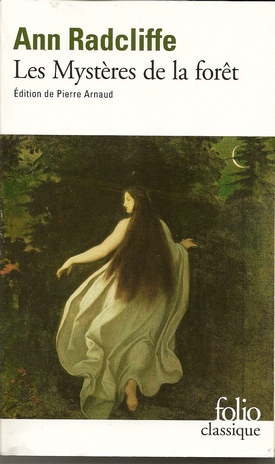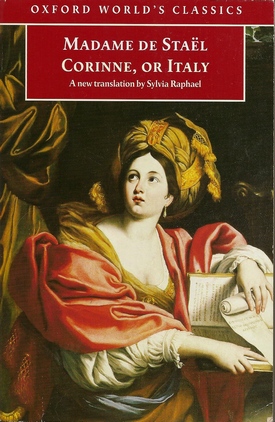Francois Soules's 1797 powerful translation of Radcliffe's Romance of the Forest
Proposal for a talk to be given on a panel for translation studies: “Pride and Prejudices: Women's Writing of the Long Eighteenth Century.
''To translate seemed to me a beautiful thing to do”: Translation as Matching Creative Act
I recommended him to read Corinna (Austen's Letters, Tues- Wed, 27-28 December 1808)In the long winter of 1784, which I passed in Normandy, this little Novel fell into my hands … for their amusement, I translated [into English] as I read [the French], the most striking passages of the story; which appeared to me so interesting that I was induced to translate the whole; or rather to write it anew in English — Charlotte Smith, from her preface to her Manon
The idea of making a name for myself in the Republic of Letters animated all my faculties — Victorine de Chastenay, on first beginning to translate Radcliffe’s Udolpho1
I propose to juxtapose two comparative studies of characteristic interactions between French and English texts in order to tell an exemplifying story of later 18th century writers translating, adapting, imitating from French to English and English to French and back again. Charlotte Smith transformed Prévost's Histoire de Chevalier des Grieux et de Manon Lescaut (1731) and Gayot de Pitaval's Causes Célèbres et Interessants (1734-44) to bring into the English imaginary some explosively transgressive reality-based material from sexual and familial life. From what she learned in this exploration, she turned gothic and sentimental romance into vehicles for critiquing the ancien regime as it was experienced in the UK at the time. Her Ethelinde, or the Recluse of the Lake (1790) her first fully poetic landscape novel was translated into French by M. De Montagne, who made of it a romantic “paysage” central and anticipated the peculiar mix of vast architecturally-organized landcapes within which we experience in Smith explorations of depressive states, social dysfunction, and explicit debates on ideological stances of the era. These sort of landscapes became an accepted mode in France as well as England and just a little later we find in them in Radcliffe nightmare scenarios of nervous distraught pursuit and chase, near rapes, and explorations of unjust imprisonment, familial abuse, murders, and harrowing hostage experiences. The principle of my study will be to reject the sterile and misleading one of accuracy and instead look upon translation as a creative match. I'm following the theories and practice of David Bellos in his Is That a Fish in My Ear?; I'm also basing my assumptions on Mary Helen McMurran's The Spread of Novels where she demonstrates that translators in the 18th century were not hacks, but genuinely motivated artists.
I will begin with my findings from a close comparison of Smith's Manon L'Escaut, or The Fatal Attachment (suppressed at first so that it never became as influential as it could have been) with Prévost's later revised text (1753, the one Smith used), and Smith's Ethelinde with M. De Montagne's Ethelinde ou la récluse du Lac (1796). I will show how much may be discovered when we study the translations as valuable texts in their own rights which then influence writers and readers who read the translations. I will show that in Smith's version Prévost's enigmatic text intended to justify amoral decisions for aristocratic male rraders becomes a story genuinely focused from the point of view of a pro-active heroine with a realistic pragmatic consciousness, and that Montagne's romantic translation engages deeply, linguistically melodiously with Smith's landscape to bring forward Ethelinde and other of Smith's characers as socially critical and troubles figures within a haunted poetic landscape.
The second and concluding part of my story will present my findings from my close study of Radcliffe's 1794 Mysteries of Udolpho, with Victorian de Chasteney's 1797 Les Mystères d'Udolphe in the context of Radcliffe's A Journey Made in the Summer of 1794 (published 1795) and Mémoires de madame de Chastenay, 1771-1815 (written between 1810 and 1817, published 1896) . Again I'll align two texts, this time Radcliffe and Chastenay's masterpieces to bring out their distinctive qualities and show how Chastenay's implicit insight into the core psychology of Radcliffe's text is imbricated with the sheer sensibility of Chastenay's forceful romantic paysage; what Chastenay loses in subtlety, she gains in her social understanding of emotionalisms embedded in the landscapes. At the same time she is as politically engaged as Radcliffe. Chastenay resembles Radcliffe in her reformist radical agenda, in her case much modified by her family's devastating experience of the revolution (including imprisonment, lose of property, and her father having nearly been guillotined). I will suggest that reading these texts (as people still do) as sheer female gothic obscures their critiques of the social, economic and political order which are valuable in themselves, which influenced other important books (e.g., George Sand's Consuelo/La Comtesse de Ruddolstadt, influenced by Radcliffe through Chasteney), and speak to us today. I demonstrate the political critiques and deep congeniality is there by describing the until recently unfortunately-neglected travel book by the one author, and autobiography of the other.
My larger goal is to call attention to a large body of work still ignored 2, to which these translations belong. When these books are studied the arguments often resemble those film adaptations once had to contend with: evaluation and judgement based solely on a one-to-one literal comparison with the assumption the first text is necessarily the most important and better. I want to show microanalysis is still at the core of translation study but when we change our assumptions how much we have to learn and how many new and fascinating texts to read. Even if I am going to explicate the visions of the particular translations I've chosen, my purpose is to do a translation study. I understand that I have two sets of texts here, so to fit in the twenty minutes I'm going to present my findings, not whole-scale analyses. On the principle of one swallow does not a summer make I could seek to make my argument about how to read and judge translated texts stronger. Smith's Manon was suppressed and people are unaware of how she alters that text to make Manon the center and an active heroine (at least in Manon's mind) and Montagne's Ethelinde is a nearly anonymous and thus disrespected text. So they make an effective comparison and contrast with Chastenay's whose text is still read in France and countries where French is read.3
Notes
1 “A cette époque aussi je traduisis Udolphe et l'idée de me faire un nom dans la république des Lettres ranima toutes mes facultés. Une traduction de roman anglais me semblait une assuez belle chose. Udolphe, d'ailleurs, me causait un ébranlement dans l'imagination, dont ma raison n'a jamais su me préserver. Les terreurs d'un bruit sourd, d'une ombre prolongé e, d'un effet fantastique enfin, m'atteignent encore common un enfant et sans que j'en puisse trouver la cause” -- Madame de Chastenay quoted by Maurice Lévy, 'Notice,” Ann Radcliffe, Les Mystères d'Udolphe (Paris: Gallimard, 2001):879-80.
2 Items from this terrain include Isabelle de Montolieu's influential translations of Austen into French, Felix Fénéon's gem, Catherine Morland (1898/99, reprinted by Gallimard 1946), and recently Pierre Goubert's translated texts and studies of Austen3; the two 1807 translations Stael's Corinne, ou L'Italie into English (one read and much admired by Austen), Isabel Hill's 1884 Victorian and two recent renderings, one brilliant one by Sylvia Raphael (often unmentioned, printed as an Oxford Classic, 1998). Where relevant I will touch upon translations into Italian to widen our purview beyond two languages. Studying translations can lead us to understand both source and target texts , individual authors as well as the larger trajectories of international book history in newly fundamental or concrete way
3 See my Austen Reveries blog where I develop this idea through analysis of texts using Francois Soules's translation of Radcliffe's The Romance of the Forest and Andre Morellet's translation of her The Italian “Radcliffe Made French.”
Works Cited
- Astbury, Katherine. “Charlotte Smith's The Banished Man French Translation: or, the Politics of Novel-writing during the Revolution,” Charlotte Smith in British Romanticism, ed. Jacqueline Labbe. London: Pickering and Chatto, 2008. 129-44.
- Dow, Gillian. “A review of Robert Frail's Singular Duality,” Translation and Literature, 17:1 (2008):127-31.
- Ethelinde ou la récluse du lac par Charlotte Smith, traduit par M De La Montagne, auteur de plusieurs ouvrages dramatiques, 4 vols. London and Paris: Lavillette, 1790.
- Frail, Robert. A Singular Duality: Literary Relations Between France and England in the Eighteenth Century. NY: AMS Press, 2007.
- Medlin, Dorothy, “Across the Channel: French translations of Radcliffe's The Mysteries of Udolpho,” La Traduction des Langues Modernes au VXIII siècle, ed. Annie Rivara. Paris: Honor Champion, 2002. 191-208.
- Moody, Ellen. “The Nightmare of History in Ann Radcliffe's Landscapes”. A paper delivered at a meeting of the South Central Region of American Society for Eighteenth Century Studies conference. February 2012. On-line: http://www.jimandellen.org/LandscapeMemoryNightmareHistory.html
- ----------------- “Jane Austen in French.” Ekleksographia: Wave Two, Translation Special, ed. Anny Ballardini. October 2009. On-line journal: http://ekleksographia.ahadadabooks.com/ballardini/authors/ellen_moody_reviews.html
- ----------------. “Continent Isolated: Anglocentricty in Austen Criticism,” Re-Drawing Austen: Picturesque Travels in Austenland, edd. Beatrice Battaglia and Diego Saglia. Napoli: Liguori Editore, 2004. 329-39.
- -----------------. “Continent Not Isolated: Jane Austen among French Women.” A paper delivered at a meeting of the Eastern Region of American Society for Eighteenth Century Studies. October 2003. Online: http://www.jimandellen.org/austen/JAAmongFrenchWomen.html
- Sol, Antoinette. Textual Promiscuites: Eighteenth-Century Critical Rewriting. Lewisburg: Bucknell UP, 2002. A study of textual relationships among the novels of Riccoboni, Burney and LaClos.
- Tremblay, Isabelle. "Isabelle de Montolieu (1751-18320, Caroline de Lichtfield, ou Memoires d’une Famille Prussienne, ed. Ellen Moody. http://www.jimandellen.org/montolieu/caroline.show.html," Eighteenth Century Fiction, 22:4 (Summer 2010):739-741
- Wright, Angela. “Corinne in Distress: Translation as cultural misappropriation in the 1800s,” CW3 Journal: Corvey Women Writers Journal on the Web, 1796-1834, n.d. On-line. http://www2.shu.ac.uk/corvey/cw3journal/issue%20two/wright.html
Superb 1998 translation of Stael's novel, a gem in its own right
Home
Contact Ellen Moody.
Pagemaster: Jim Moody.
Page Last Updated 26 January 2013

